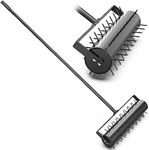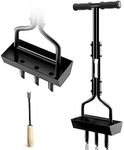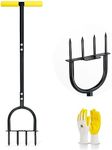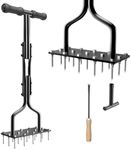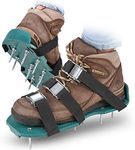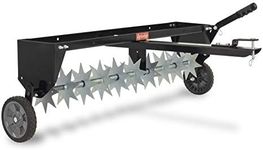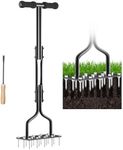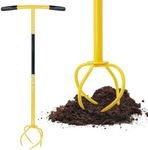Buying Guide for the Best Manual Lawn Aerators
Choosing a manual lawn aerator is all about matching the tool to your lawn’s size, soil type, and your own comfort. Aerating your lawn helps the soil breathe, improves water absorption, and encourages healthy grass growth. Since manual aerators require physical effort, it’s important to pick one that suits your strength and the specific needs of your yard. Understanding the main features will help you make a choice that keeps your lawn healthy without making the job too hard for you.Aeration TypeAeration type refers to how the tool creates holes in the soil. The two main types are spike and plug (core) aerators. Spike aerators simply poke holes in the ground, while plug aerators remove small plugs of soil. Spike aerators are easier to use and lighter, but plug aerators are more effective for compacted soil because they actually remove soil and allow for better air and water flow. If your lawn is heavily compacted or has clay soil, a plug aerator is usually better. For lighter, sandy soils or for regular maintenance, a spike aerator may be sufficient.
Working WidthWorking width is the area the aerator covers in one pass. Wider aerators cover more ground quickly, making them better for larger lawns, but they can be heavier and harder to maneuver. Narrower aerators are easier to handle and control, especially in small or oddly shaped yards, but will take longer to finish the job. Consider the size and shape of your lawn when deciding on the working width that will be most comfortable and efficient for you.
Tine LengthTine length is how deep the spikes or plugs go into the soil. Longer tines reach deeper roots and are better for breaking up compacted soil, but they require more effort to push into the ground. Shorter tines are easier to use but may not be as effective for deep aeration. If your lawn has shallow roots or you’re just doing light maintenance, shorter tines are fine. For thicker, compacted lawns, look for longer tines to get the best results.
Handle DesignHandle design affects how comfortable and easy the aerator is to use. Some have straight handles, while others have T-shaped or cushioned grips. A comfortable handle reduces strain on your hands and back, especially if you have a large area to cover. If you have any physical limitations or want to avoid fatigue, look for ergonomic handles or padded grips that make the job easier.
WeightThe weight of the aerator influences how easy it is to use and how effective it is at penetrating the soil. Heavier aerators can push tines deeper with less effort, but they can be tiring to lift and maneuver. Lighter aerators are easier to handle but may require more force from you to get the tines into the ground. Choose a weight that you can comfortably manage for the size of your lawn and the amount of time you’ll spend aerating.
Build MaterialBuild material determines the durability and lifespan of the aerator. Steel is strong and long-lasting, making it a good choice for tough or rocky soil, but it can be heavier. Aluminum or plastic parts are lighter but may not hold up as well over time. If you plan to aerate often or have hard soil, go for a sturdy, mostly metal construction. For occasional use on softer lawns, lighter materials may be sufficient.





